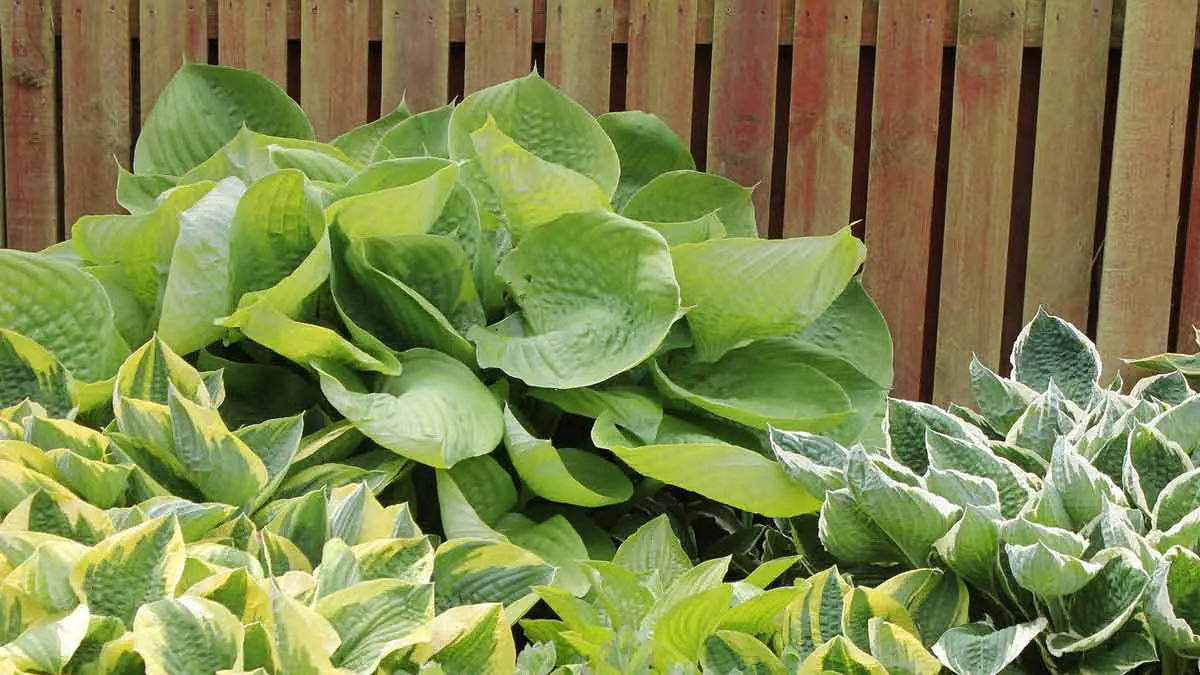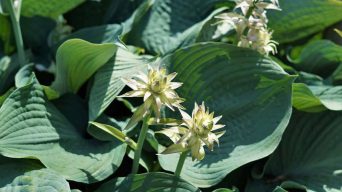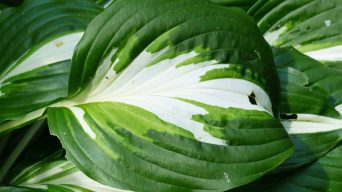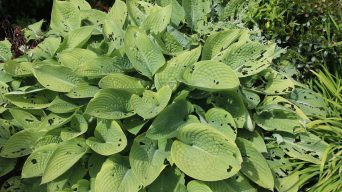Gardening is a labor of love. And when it comes to selecting plants, hostas (Plantain lilies) are a favorite among green thumbs. Their striking foliage and low maintenance make them a go-to choice for any garden.
But sometimes, you may want to encourage your hostas to grow bigger and faster. If this is the case, look no further.
I have compiled a list of 15 expert tips to help your hostas reach their full potential.
From selecting the right hosta varieties to preparing the soil and proper watering and fertilizing, we’ve got you covered. Follow these tips and watch your hostas thrive.
1. Choose the Right Hosta Varieties
When selecting hostas for your garden, look for varieties that are known to be large-growing.
Examples of giant hosta varieties include ‘Stained Glass’, ‘Big Daddy’, and ‘Sum and Substance’. These varieties sometimes boast substantial leaves, up to two feet long! Additionally, they are tolerant of a wide range of conditions – from full sun to deep shade – so they are an excellent choice for any garden.
Beyond size, look for hostas that provide a range of colors and leaf shapes.
For example, ‘Big Daddy’ has rounded blue leaves; ‘Sum and Substance’ has heart-shaped light green leaves; and ‘Stained Glass’ has a variegated foliage of yellow leaves with dark green margins. This hosta variety is great for adding a color to the landscape!
When selecting large hosta plants for your garden, you should also consider the overall look of your space. Consider how the different varieties will work together to create an attractive display and choose the ones that best complement each other.
Additionally, pay attention to their mature size; some may outgrow their allotted space if left unchecked!
2. Plant Your Hostas in the Right Location
When planting hostas, look for a site that has partial shade. Too much direct sunlight can cause the hosta leaves to become scorched and discolored.
You should choose an area that receives sun in the morning and shade in the afternoon. This will protect your hosta plant from the hottest part of the day while allowing it to get sufficient sun for growth.
If you can’t find a spot with partial shade, consider planting your hostas beneath tall trees or building a structure that protects them from the sun.
3. Choose the Right Size Pot or Garden Bed
The pot or garden bed size is essential for growing hosta plants.
If you choose a container that is too small, the plant may become root-bound and stunt its growth; if you choose one that’s too large, the soil will retain moisture for too long, causing nutrient deficiency.
Selecting a pot or garden bed just the right size for your hosta is essential for maximum growth. A good rule of thumb is to choose one that’s two to three times larger than the root ball and provide enough space for at least 1″ between the sides of the container and the edge of the root ball.
When planting in a garden bed, the best option is to create raised beds with at least 6″ of soil so that water can easily drain away from the roots. Be sure to space plants evenly and give enough room for the hosta to grow.
The impact of pot size on hosta growth is significant.
If you choose the right size container or garden bed and provide adequate space, your hosta will be able to grow larger and lusher than if it were planted in a small, cramped environment. That’s why it’s so important to get the pot or garden bed size just right.
Finally, it’s also important to regularly check and adjust your hosta’s container or garden bed size as it grows. Doing so will ensure that enough space is available for the roots to expand, enabling the plant to reach its full potential in terms of size and health.
4. Prepare the Soil for Hosta Growth
When it comes to growing hostas, the most crucial factor is having soil with good drainage and proper pH levels. Creating a soil rich in organic matter with good structure is important. Here are some tips for creating the perfect environment for hosta growth:
- Add compost or other organic materials to your soil. Compost can improve drainage while adding much-needed nutrients to the soil. You can also use peat moss, composted leaves, or other organic matter to enrich your soil and help it hold moisture.
- Amend the soil with sand or grit. Adding sand will help improve drainage and create a better root structure. You can use coarse builder’s sand, sharp sand, or horticultural grit in your soil mix.
- Adjust soil pH levels. Hostas prefer slightly acidic soil, with a pH between 6.5 and 7.5. You can buy a soil testing kit to determine the current pH levels of your soil and adjust accordingly.
- Improve soil structure. If your soil is mostly clay, it can be difficult for roots to penetrate. Adding organic matter and sand will help create better structure and drainage.
5. Water Your Hostas Properly
Watering your hostas is vital in keeping them healthy and growing bigger. Hostas are not drought-tolerant plants, so they should be watered regularly.
Depending on the climate and season, you should water your hostas regularly, about twice a week in the summer and once a week during cooler months. If you live in an area with high temperatures, you may need to water them more often.
It’s also important to avoid overwatering your hostas since too much moisture can cause root rot and stunt their growth. One way to ensure that your hostas get enough but not too much water is to use a soil moisture meter.
Finally, ensure that your hostas have adequate drainage so the water doesn’t collect in the soil and create problems for the roots. If you are planting your hostas in a pot or container, use one with proper drainage holes at the bottom.
6. Mulch Your Hostas
Mulching your hostas is one of the best ways to ensure they flourish and grow bigger.
Mulch helps retain moisture, control weeds, and regulate soil temperatures. It can also add nutrients to the soil as it decomposes over time.
When choosing a mulch for your hostas, consider factors such as the soil type, climate, and your hostas’ needs.
For instance, pine needles are an excellent option for sandy soils in warmer climates since they help retain moisture. On the other hand, wood chips or bark mulch work better on clay soils in cooler temperatures.
Mulching your hostas is easy to do – spread a 2-3 inch layer of mulch around the base of each plant. Be careful not to pile it too high, as this can suffocate the hostas and lead to root rot.
To keep your hostas healthy, be sure to reapply mulch every season.
7. Fertilize Your Hostas for Bigger Growth
When it comes to growing larger hostas, fertilizer is key. Fertilizing your hostas regularly in the spring and summer will give them the boost they need for maximum growth.
Organic fertilizers are generally better for hostas than synthetic ones because they gradually release nutrients that won’t overwhelm the plant. A balanced 10-10-10 fertilizer is a great choice for hostas and will provide them with all the essential nutrients they need to thrive.
It’s important to avoid over-fertilization as this can cause root burn and other damage to your plants. Only fertilize when necessary – usually once or twice during the growing season – and always follow the directions on the package for best results. Additionally, ensure to water your hostas well after fertilizing as this will help reduce salt build-up from the fertilizer.
8. Protect Your Hostas from Pests and Diseases
It’s important to take steps to protect your hostas from common pests and diseases.
Slugs, aphids, and caterpillars are some of the most common garden pests that like to feed on hostas.
To control these pests, you can create a barrier around the plants with diatomaceous earth or use an organic pesticide like neem oil.
You can also use other natural methods to control these pests, such as picking slugs and snails off the plants and encouraging beneficial insects like ladybugs to take up residence in your garden.
Fungal diseases can also affect hosta plants. The most common is powdery mildew, characterized by white spots on the hosta leaves.
To help prevent this disease, ensure you water plants at the base rather than overhead and keep them in an area with good air circulation.
Removing any dead or decaying leaves can also help keep your hostas healthy. Finally, use a fungicide if necessary to treat any existing fungal infections.
9. Prune Your Hostas to Promote Bigger Growth
Pruning is a great way to encourage big and healthy growth for your hostas. This involves removing dead leaves and stems and thinning out the center of some varieties so that more light can get in and help promote new growth.
Pruning can improve the overall look of your hostas and is especially beneficial during the flowering season. Pruning also helps to keep the plants healthy as it reduces overcrowding, prevents diseases from spreading, and encourages air circulation, which helps to prevent fungal growth.
To get the most out of pruning for hosta growth, here are some tips:
- Prune your hostas in the early spring. This is when new growth starts to emerge from the center of the plant and before it begins to bloom.
- Make sure you use sharp pruning shears or scissors to get a clean cut, which helps to prevent diseases from entering the plant.
- If a stem is dead or diseased, it is best to remove it altogether.
- Only cut about one-third of the foliage back when pruning for bigger growth. Over-pruning can be damaging and could stop your hostas from flowering that season.
- Prune in stages rather than all at once. This helps to keep the hostas looking attractive and growing bigger for longer.
- Make sure you check your hostas regularly during their growing season to remove any dead or diseased growth quickly.
10. Divide Your Hostas When Necessary
Dividing your hostas is not always necessary for them to grow bigger. Still, it can be beneficial if you have a clump that is getting overcrowded or has stopped flowering.
To determine when to divide your hostas, look at the size and age of the plant. If it’s well established (3-5 years old), larger than one foot in diameter with thick stems, and the leaves have started to look crowded or small, it’s likely time for a division.
Here are some tips for dividing and transplanting your hostas:
- Early spring or late summer are the optimal times of year to do this.
- Dig up the plant and gently remove it from the soil—taking care not to damage the roots.
- Divide the clump into sections using a garden knife or spade. Each section should have multiple leaves, stems, and roots attached.
- Replant each of these sections in well-draining soil at least one foot apart.
- Don’t water immediately after transplanting, as this can cause shock. Instead, wait a few days and then water lightly to encourage further growth.
- Mulching around the plant will help conserve moisture and prevent weed growth.
11. Protect Your Hostas from Extreme Weather
Hostas are beautiful ornamental plants that can add color and texture to any garden but may not thrive during extreme weather conditions.
Extreme cold or heat could cause them to become stressed, resulting in stunted growth or even death.
Fortunately, you can take a few simple steps to protect your hostas from extreme weather and help them thrive.
- Keep hostas out of direct sunlight. Too much sun can cause the leaves to burn and stunt growth. Try planting your hostas in an area with partial or filtered sun, or use shades such as trees, shrubs, or awnings to protect them from harsh sunlight.
- Mulch your hostas in the wintertime. Mulching will help insulate the soil, protect the root system from freezing temperatures, and help retain moisture.
- Water your hostas regularly during dry spells. Keeping them adequately hydrated during hot weather helps them cope better with heat stress.
- Avoid pruning or transplanting when temperatures are very high or cold. Pruning and transplanting can put extra stress on your hostas, making them more vulnerable to extreme weather.
- Provide shelter during storms or high winds. Protecting your hostas with a windbreak can help prevent damage from heavy wind gusts.
12. Provide Adequate Space
When it comes to making hostas grow bigger, one of the most important factors is providing enough space to spread and thrive.
Hostas are hearty perennials that can take a lot of wear and tear, but they need room to grow to reach their full potential. Placing your plants too close together will lead to overcrowding and can stunt their growth.
Plants that are too close together reduce air circulation, leading to fungal diseases like powdery mildew. It also stresses the plants and causes them to compete for resources like sunlight and moisture. This competition can cause them to produce fewer flowers, grow more slowly, and eventually become stunted.
Ideally, you should aim to provide at least two feet of space between each hosta plant for it to grow optimally. This gives them enough room to spread out and develop strong root systems that can absorb nutrients from the soil more effectively.
If you’re planting a lot of hostas in one area, it’s best to use a staggered spacing pattern for the optimal growth of all plants.
In addition to providing enough space between each plant, you should also ensure that the site is large enough for your hostas to grow. If there is enough room in an area for them to spread out, they will be able to reach their full potential.
13. Keep the Area Around Your Hostas Weed-Free
Weeds can be very detrimental to the health of your hostas as they compete for nutrients and water.
Keeping the area around your hostas weed-free is key in ensuring their growth isn’t stunted or harmed.
If you have weeds growing in the soil, remove them as soon as possible.
Regularly checking for new growth can help prevent their spread and keep your hostas healthy.
You should also consider investing in a good quality weed-control product or mulching around your plants to discourage weeds from growing near your hostas.
By removing the weeds and preventing new growth, your hostas will have access to the nutrients, oxygen, and water they need to thrive. This, in turn, may result in larger, healthier hosta plants with vibrant foliage.
14. Use Epsom Salt To Make Hostas Grow Bigger
Epsom salt is a natural mineral compound consisting of magnesium and sulfate, known for its effectiveness in promoting plant health. It can make hostas grow bigger while improving soil structure and controlling pests.
For application, pour the diluted mixture around the base of your hostas and gently work it into the soil. Epsom salt should not come in contact with the foliage as it can cause leaf burn. It is also important to avoid applying too much as this can damage the plant’s growth habit.
For best results, apply once every three weeks throughout the growing season.
Mix one cup of Epsom salt in a gallon of water for larger hostas. For more miniature hostas, use half a cup per gallon of water.
Aside from promoting more significant and healthier hosta growth, Epsom salt can also improve soil structure by loosening hard clay soils or tightening sandy soils for better moisture retention. It can also help deter pests such as slugs and snails and make plants more resistant to diseases.
Epsom salt is a great way to nourish hostas and promote bigger growth naturally.
15. Regularly Monitor and Inspect Your Hostas for Signs of Stress or Damage
When making hostas grow larger, it’s essential to regularly monitor their health and inspect them for any signs of stress or damage. Symptoms that should be watched include yellowing leaves, wilting foliage, pest infestations, disease development, and nutrient deficiency.
If any of these symptoms are observed, it’s vital to take action as soon as possible.
Yellow hosta leaves are usually a sign of nutrient deficiencies, so it could be beneficial to fertilize the soil around your hostas with a slow-release fertilizer for better results.
If you notice pests around the hosta, such as slugs or snails, it’s best to remove them manually or use an organic insecticide to get rid of them.
Diseases such as powdery mildew, rust, or leaf spot can be treated by removing affected leaves and spraying the hosta with a fungicide.
Regularly checking on your hostas is key to making them grow bigger. If you notice any signs of stress or damage, address the problem quickly so your hostas can return to good health and continue growing big and strong.
Final Thoughts
Growing hostas can be a rewarding experience, and it can unleash the potential of these beautiful shade-loving perennial plants.
With the proper care, hostas can quickly reach their maximum size potential. Providing the right light, water, and nutrients is important for keeping your hostas healthy and preventing disease.
Ensuring that your plants are planted in an optimal spot can also make a huge difference in maximizing their size potential. With the right care and attention, you can be sure that your hostas will thrive and grow big and beautiful.







